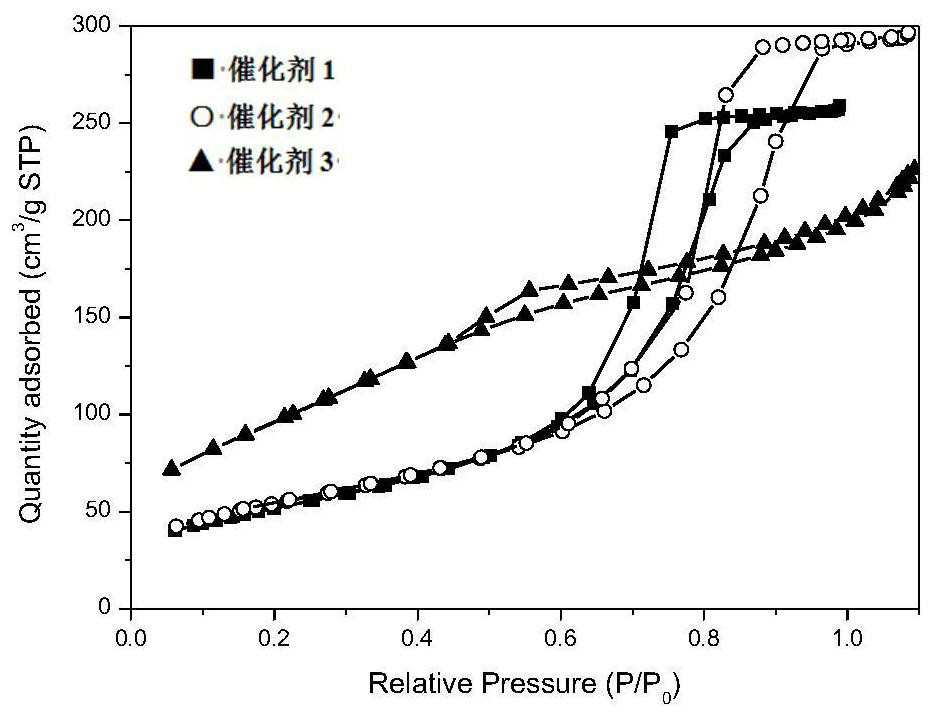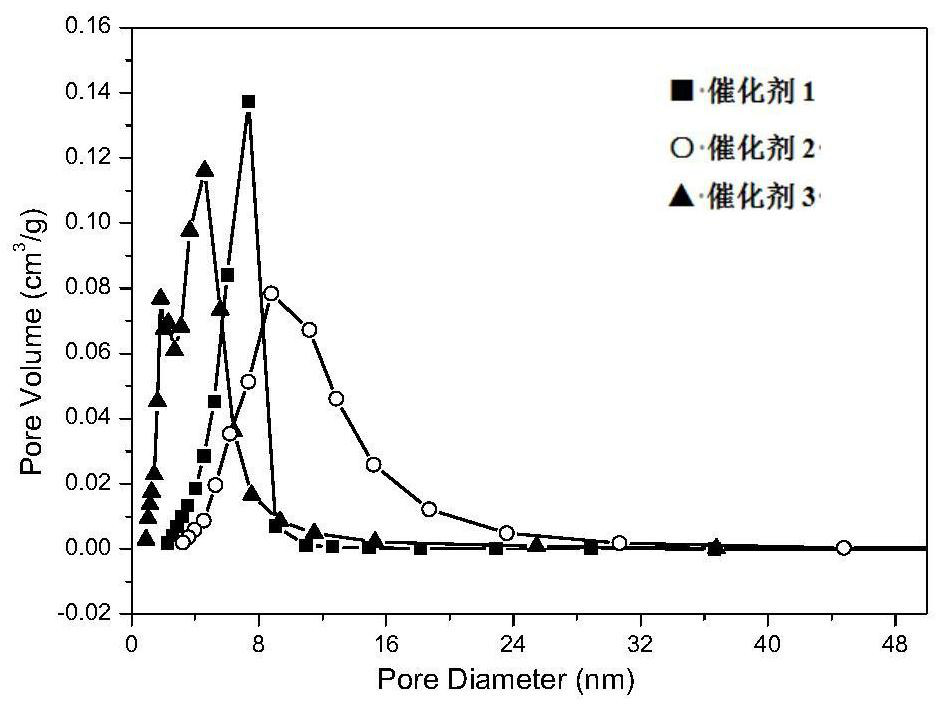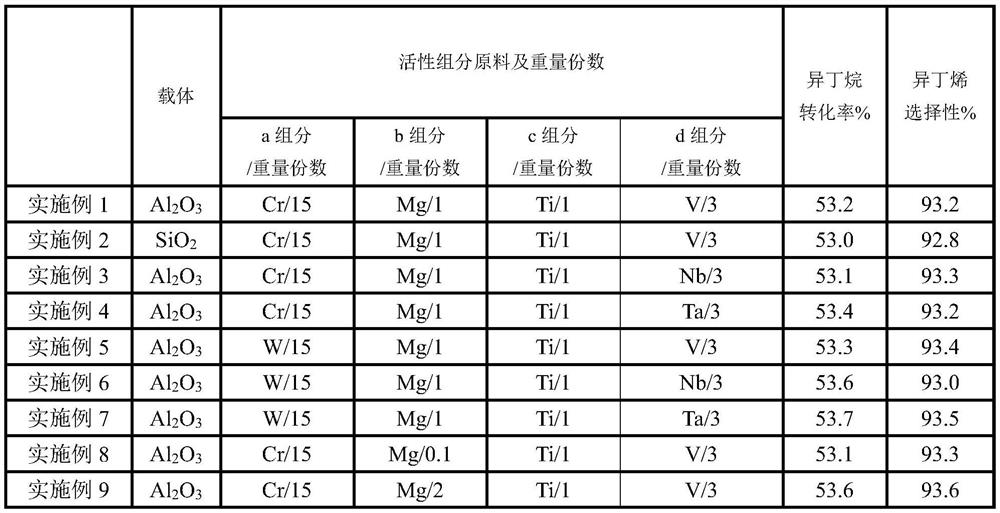Catalyst for producing isobutene by dehydrogenating isobutane
A technology of dehydrogenation catalyst and isobutane, applied in the direction of catalyst, catalyst carrier, carbon compound catalyst, etc., can solve the problem of low activity and selectivity of isobutane dehydrogenation catalyst
- Summary
- Abstract
- Description
- Claims
- Application Information
AI Technical Summary
Problems solved by technology
Method used
Image
Examples
Embodiment 1
[0045] Weigh 1372.4 grams of aluminum nitrate, 5.94 grams of PVA, 220 milliliters of water, add 3.70 grams of magnesium nitrate at the same time, stir for 30 minutes, add ammonia water dropwise to keep the pH value at 9.5, leave the sol overnight, and then move it into an autoclave at 150 ° C Conditions, kept for 24 hours, then cooled the sample, washed 3 times with deionized water, until the Cl in the filtrate - , SO 4 - The ion content is lower than 50ppm; dry at 100°C for 6 hours, move into a muffle furnace and bake at 650°C for 4 hours to obtain an alumina carrier. Get 100 grams of aluminum oxide to carry out tabletting, sieve, and record as carrier I. Weigh 79 grams of chromium nitrate, 1.26 grams of sodium titanate, and 6.9 grams of ammonium vanadate, add them to 100 milliliters of deionized water, then add 82 grams of alumina carrier I, adjust the pH value of the solution to 3.5 with 2.5% ammonia water, and then After soaking in a water bath at 80°C for 1 hour, the s...
Embodiment 2
[0049] Weigh 500 grams of silica sol with a solid content of 20%, add 100 milliliters of water, and add 3.70 grams of magnesium nitrate at the same time, stir for 30 minutes, add ammonia water dropwise to form a sol, place the sol overnight, then move it into an autoclave, and heat it at 150 ° C. , kept for 24 hours, then cooled the sample, washed three times with deionized water; dried at 100°C for 6 hours, moved into a muffle furnace and calcined at 650°C for 4 hours to obtain a silica carrier. Get 100 grams of silicon oxide for tableting and sieving, and record it as carrier I. Weigh 79 grams of chromium nitrate, 1.26 grams of sodium titanate, and 6.9 grams of ammonium vanadate, add them to 100 milliliters of deionized water, then add 82 grams of silica carrier I, adjust the pH value of the solution to 3.5 with 2.5% ammonia water, and then After soaking in a water bath at 80°C for 1 hour, the sample was taken out for filtration, dried in an oven at 120°C for 8 hours, and th...
Embodiment 3
[0051] Weigh 1372.4 grams of aluminum nitrate, 5.94 grams of PVA, 300 milliliters of water, add 3.70 grams of magnesium nitrate at the same time, stir for 30 minutes, add ammonia water dropwise to keep the pH value at 9.5, leave the sol overnight, and then move it into an autoclave at 150 ° C Conditions, kept for 48 hours, then cooled the sample, washed 3 times with deionized water, until the Cl in the filtrate - , SO 4 - The ion content is lower than 50ppm; dry at 100°C for 6 hours, move into a muffle furnace and bake at 650°C for 4 hours to obtain an alumina carrier. Get 100 grams of aluminum oxide to carry out tabletting, sieve, and record as carrier I. Weigh 79 grams of chromium nitrate, 1.26 grams of sodium titanate, 12.14 grams of niobium oxalate, add to 100 milliliters of deionized water, then add 82 grams of alumina carrier I, adjust the pH value of the solution to 3.5 with 2.5% ammonia water, and then After soaking in a water bath at 80°C for 1 hour, the sample was...
PUM
| Property | Measurement | Unit |
|---|---|---|
| Specific surface area | aaaaa | aaaaa |
Abstract
Description
Claims
Application Information
 Login to View More
Login to View More - R&D
- Intellectual Property
- Life Sciences
- Materials
- Tech Scout
- Unparalleled Data Quality
- Higher Quality Content
- 60% Fewer Hallucinations
Browse by: Latest US Patents, China's latest patents, Technical Efficacy Thesaurus, Application Domain, Technology Topic, Popular Technical Reports.
© 2025 PatSnap. All rights reserved.Legal|Privacy policy|Modern Slavery Act Transparency Statement|Sitemap|About US| Contact US: help@patsnap.com



